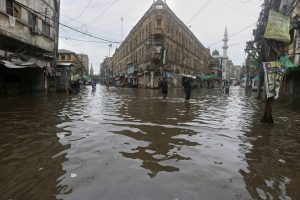Every monsoon season a similar tale unfolds in Karachi, Pakistan’s largest city, located along the coast of the Arabian Sea.
At the first sight of dark clouds, the citizens of Karachi grow anxious about the impending doom from heavy rain. For far too long the same situation has emerged each year: flooded roads and streets, entire neighborhoods submerged in muddy rainwater, innocent lives lost, and people getting stuck on the deluged roads for hours at stretch, wading through inundated streets and roads.
This year was no different. Perhaps even worse, as the city, also Pakistan’s financial and industrial hub, received record-breaking amounts of rain. In the second spell of monsoon rains, starting on July 24, the city received more than an entire summer’s worth of rain in one day.
As per the Provincial Disaster Management Authority Sindh, as of August 1, 45 people had lost their lives to this year’s monsoon in Karachi alone
Monsoon rains have wreaked havoc across Pakistan. According to the latest report by the National Disaster Management Authority, more than 500 deaths occurred across the country over the past six weeks. Over 39,000 homes have been either partially damaged or fully destroyed by the deluge, along with the destruction of infrastructure such as highways, roads, and bridges.
Sherry Rehman, minister for climate change, said that this year Pakistan received 87 percent heavier than average rainfall, linking the torrential rains across the country to climate change.
Pakistan has been rated as one of the most climate-vulnerable countries across the world by the Global Climate Risk Index.
Is the severe urban flooding, and the subsequent aftermath, in the metropolitan city entirely due to climate change? The question begs to be answered.
Why Does Karachi Flood Every Year?
Analysts link Karachi’s rain woes to misgovernance, arguing that maintenance and monitoring of infrastructure and additions to it are necessary to equip the city to face heavier downpours without drowning.
“Karachi doesn’t drown as much because of rain as it does because of criminal neglect towards governance of this city and a lack of understanding towards governance,” Fahim Zaman Khan, former administrator of Karachi, told The Diplomat.
Renowned architect and urban planner Arif Hasan seconds this. He believes that the government is failing every year because its “diagnosis of the problem” is not correct.
To understand why Karachi floods almost every year when it rains, it is important to understand the issues plaguing the sewage and drainage systems of the city. One of the biggest issues of the city is the lack of a properly functioning drainage system.
Karachi’s stormwater drains, locally called nullahs, flow into two seasonal rivers, the Lyari and Malir, which begin in the foothills of Kirthar range and run parallel to each other.
According to the Karachi Water and Sewerage Board, the city has 64 big nullahs, which carry the water of their catchment areas. In addition to these big nullahs, there are thousands of smaller nullahs that drain into them. This entire network, from smaller nullahs to big nullahs and then the two rivers, comes together and finally falls into the sea.
“Over the years the storm water drains of Karachi have been misused. On many smaller stormwater drains, illegal constructions have taken place,” explained Khan.
Khan added that Karachi’s population has exploded over the last seven decades since independence. With a booming population and an absence of sustainable social housing policy, people have started to create informal housing settlements, locally called katchi abadis, along the nullahs. Construction near the storm water drains wasn’t restricted to just the informal housing settlements, though.
In an article titled “Why Karachi Floods,” Arif Hasan writes: “Meanwhile, the Government of Sindh, for its own use, has constructed car parking facilities, offices and a MPA hostel on the nullahs and even part of the registry of the Supreme Court of Pakistan is constructed on a nullah.”
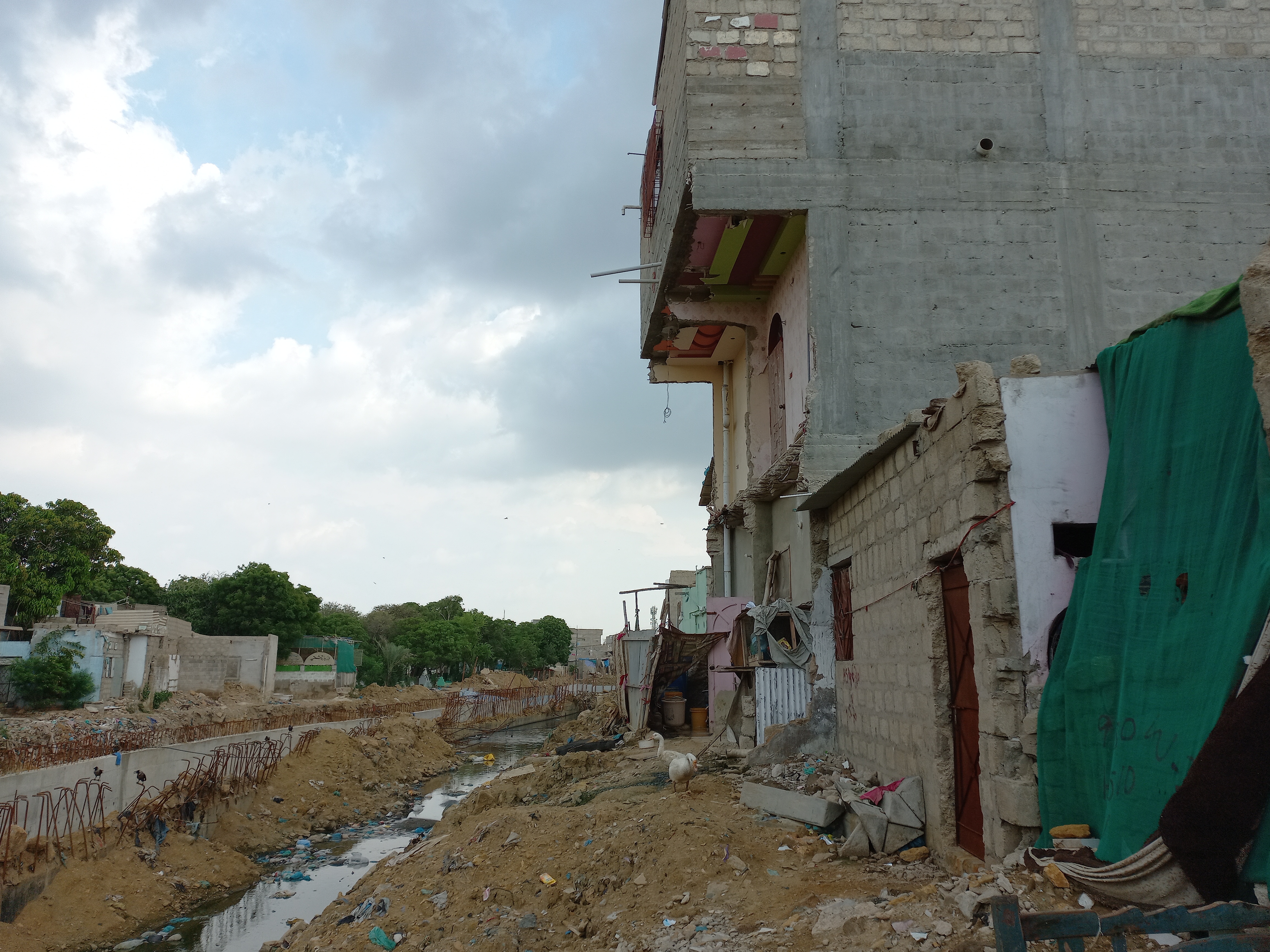
Demolished houses along Orangi nullah. Photo by Somaiyah Hafeez.
Due to the lack of separate drainage and sewage systems in the city, both formal and informal settlements started to dispose their sewage into the nullahs – a practice that has continued since the mid-1960s. This has resulted in most of the nullahs and their tributaries becoming clogged from the accumulated sludge.
When it rained, the waste would wash off, but when it didn’t rain for years the sludge would solidify in the nullahs, which would rarely be cleared out by the local government.
For a spatially large city of 3,780 square kilometers, Karachi only has two landfill sites, both located in District West. That means solid waste has to be carried for more than 40 kilometers from the eastern parts of the city to reach the sites. Owing to the distance, time, and costs required for this, much solid waste from major parts of the city never reaches the landfill sites. Much of the waste is instead dumped into nullahs. By the mid-1990s most of the nullahs in the city were choked with solid waste.
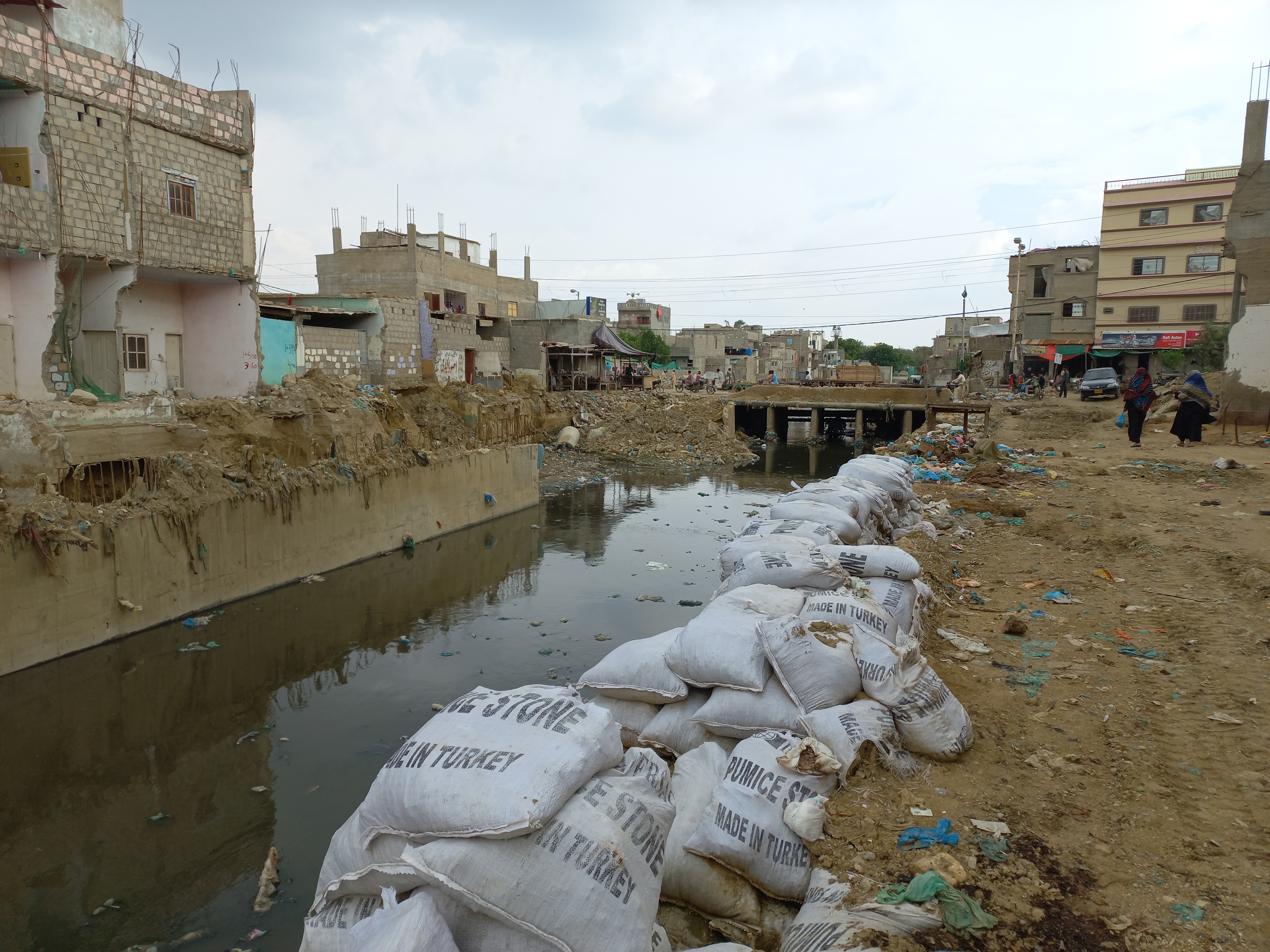
Locals say that the Orangi nullah had not been cleaned in 30 years and it remains clogged with solid waste a year and a half after a cleaning process began. Photo by Somaiyah Hafeez.
Another factor that contributes to urban flooding in the city is the haphazard planning: each year the rains expose the substandard quality of infrastructure of the city.
For example, Karachi’s roads turn into rivers as soon as it rains. Hasan explains that this is because when a road is built, the tender documents require the construction of drains alongside the roads; however, there’s nowhere for this drainage to go. These drains do not have a disposal and end where the road ends, causing rainwater to pile up.
However instead of addressing the issues with the city’s drainage system, the government has carried out mass evictions along the nullahs.
Evictions Along Gujjar and Orangi Nullah
After the 2020 Karachi floods, which resulted in 41 deaths, the Sindh government bulldozed hundreds of houses along Gujjar and Orangi nullah, as a part of its anti-encroachment drive to clear up the waterways.
Hasan believes that even though all encroachments add to the flooding, the informal settlements along the waterways don’t play a major role.
“The major role is the failure of the water to exit through the outfalls into the sea. The encroachment on the nullahs at the outfalls are not katchi abadis but the more posh areas in the city,” he said.
Even after removing encroachments along Gujjar and Orangi, the issue persists, but now thousands of people are forced to live in partially demolished houses, with no compensation given by the government.
According to the locals, their houses, which they built after years of hard work, were leased by the Karachi Development Authority (KDA). According to the lease, a notice should have been given to them along with relocations before the demolitions. They also believe that if the nullah was merely cleaned, it would have sufficed.
They say that encroachment and floods were just an excuse to demolish their homes to make a road – a project for which the nullah is actually being constricted in size.
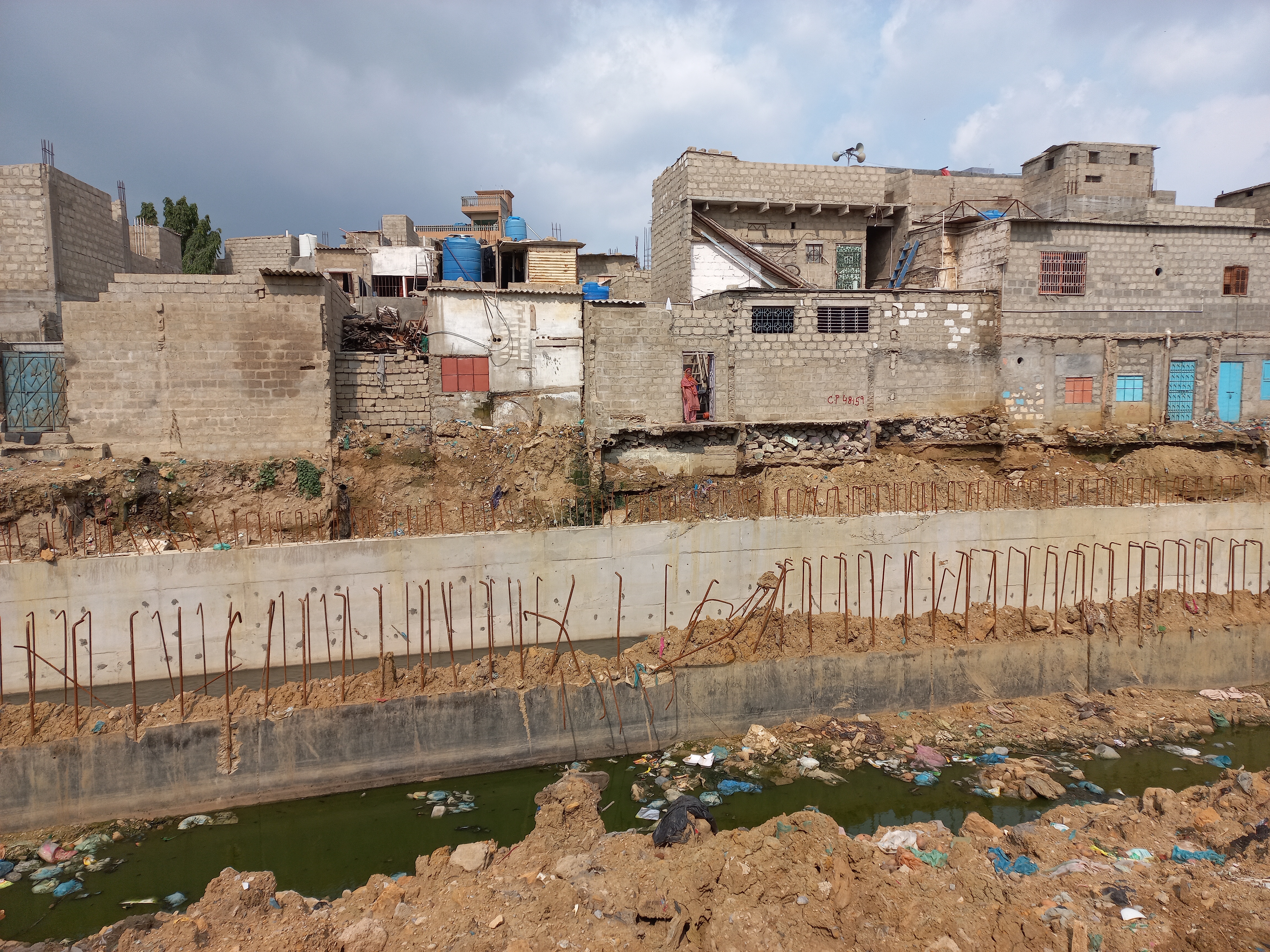
Thousands of houses were demolished along Orangi and Gujjar nullah by the government in its anti-encroachment drive after the 2020 floods in Karachi. Photo by Somaiyah Hafeez.
It has been around a year and a half since the demolitions. Locals complain that the government had assured them that within two years the project will be completed and they’ll be compensated, but work has been slow.
The Frontier Works Organization (FWO) has been assigned work on Gujja nullah and the National Logistic Cell (NLC) has been assigned with Orangi nullah but locals say that instead of doing the work, FWO and NLC have given the projects to contractors who are irresponsible, causing delays in work.
Scores of locals whose houses were demolished along Orangi nullah live in the fear of their already partially demolished houses falling due to the downpours.
“Not only have our houses been demolished but due to the negligence of the government and the slow pace of the project, we live in constant fear that our already broken houses would flood or fall if it rains for long and the nullah overflows,” said Roshan, 50.
During the first spell of torrential rainfall in the city in early July, the roof of a house collapsed along Gujjar nullah, resulting in the death of a woman.
Parveen, 40, lives with five of her children in the one room that’s left of her house after the demolitions at Orangi.
“We are constantly living in fear – what if the nullah overflows or our already broken houses fall? When it rained, we spent the entire night wet with our children, who got sick. This isn’t a house we are living in but rubble – it can fall anytime. Our roof is tin and a piece of cloth is our wall. We are constantly fearful that if the wind blows a little stronger or if it rains a little longer, we will be buried under this rubble of a house,” she said.
Residents demand that the project be completed on due time and for them to be compensated.
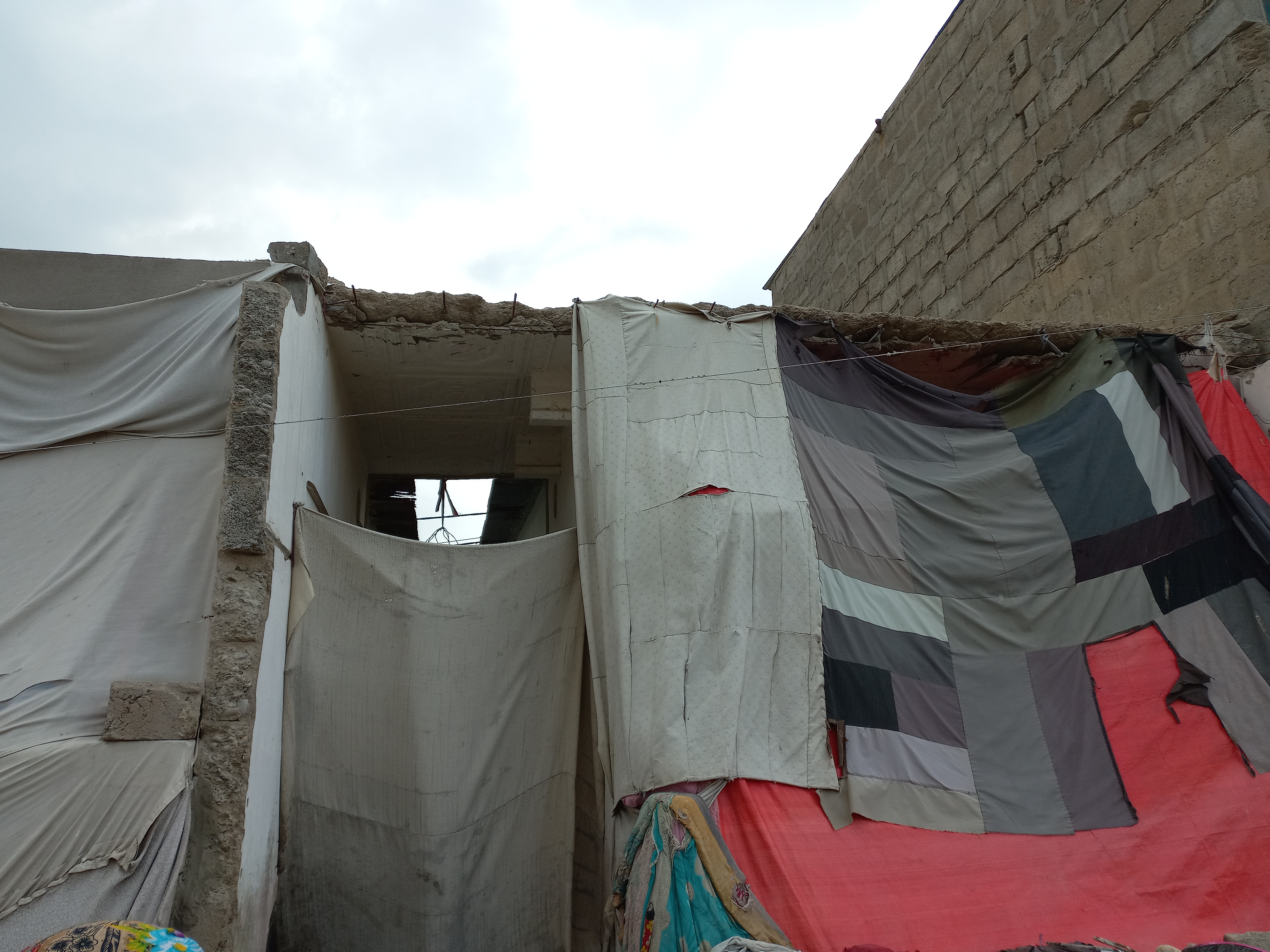
A house along Orangi nullah that has been partially demolished, forcing residents to use cloths for wall. Photo by Somaiyah Hafeez.
Rather than more demolitions, experts suggest other ways to minimize Karachi’s floods. “The solution lies in preventing further reclamation from the sea; building dams in the Malir River and its tributaries to collect water flowing in from the Kirthar Range; opening up the outfalls to the sea and – since the level of the outfalls at high tide is below the level of the sea – to create underground disposals through pipes at an appropriate distance from the shore,” Hasan told The Diplomat via email.
Khan believes that understanding of good governance is needed to solve the city’s flooding issues, which stem from poor governance.
“It is absolutely essential that a topographic survey of Karachi is done and on the basis of that, a proper drainage system has to be designed,” he said.
Flash Floods in Balochistan
Karachi is not the only place in Pakistan suffering from flooding. As of August 1, Pakistan’s NDMA reported that 149 people had lost their lives due to flooding in Balochistan, Pakistan’s impoverished southwestern province, with thousands being displaced. More than 23,000 livestock animals were killed and 3,500 houses were completely destroyed, with another 10,000-plus damaged. Roads and bridges were demolished by the floods in the province, including some connecting the cities in Balochistan with neighboring province Sindh.
Lasbela, a district in the province, is the worst hit, with hundreds of families stranded and several houses destroyed. Several videos circulating on social media show the district inundated as people, including children, are seen seeking refuge on the thatched roof of mud brick houses.
Balochistan provincial spokesperson Farah Azeem Shah, while addressing a press conference, said that Chief Minister of Balochistan Mir Abdul Quddus Bizenjo had released 92.4 million Pakistani rupees for the families of rain victims and deceased persons along with the relief operations being carried out.
However, local people complain that they have not been provided enough help. They are on their own under an open sky.
“There is no access to the areas. In some places the army conducted rescue operations in helicopters but in Bela (a city in Lasbela district) countless people are still stranded. It is raining in intervals still and our volunteers, who with a lot of difficulties reached the places for rescue work, are stranded too and we have no contact with them,” Qaisar Roonjha, a resident of the area and a social activist, told The Diplomat.
“We have been doing rescue work voluntarily and on our own. There is no administration in the district. It is cut-off since roads are disconnected and there’s no network connectivity either,” he added.
Roonjha said that the families are starving, having lost their homes and livelihood, forced to survive in these conditions with no or little assistance from the government.
Pakistan’s floods are increasingly an annual occurrence, but the government seems to be caught flat-footed every time.













